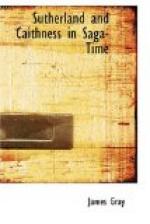CHAPTER X.
King Hakon and the North of Scotland.
We can now turn with some sense of relief from the intricate maze of the genealogy of the Caithness earls to the more open ground of Scottish history, which we left at the date of the death of William the Lion in December 1214, when he was succeeded on the throne of Scotland by his son, Alexander II, a youth who had then just entered his seventeenth year. We can then work the results of our genealogical conjectures into the general history of the northern counties.
Alexander II, like his predecessors, was in the year after his accession immediately confronted with a revolt headed by Donald Ban MacWilliam the younger, another of the descendants of Ingibjorg of Orkney, widow of Earl Thorfinn and first wife of Malcolm Canmore. The scene of the rising was, as usual, Moray; and Donald was aided not only by the inhabitants of that province, but also by a large force of Irish mercenaries. This rebellion, however, was speedily crushed by Ferchar Mac-in-tagart of the family of the Lay Abbots of Applecross in the west of Ross, a county to which Henry, the eldest son of Harold Maddadson had in vain laid claim.
Differences which threatened to break out between Scotland and England were speedily settled, and the young king, as we have seen, married Joanna, sister of King Henry III of England, in 1221. Alexander next conquered the district of Argyll in 1222, and in the same year reduced Caithness to subjection on the occasion of Bishop Adam’s murder, and he shortly afterwards put down two rebellions, the one in Moray, as above stated, and the other in Galloway, a district which, however, he did not finally conquer till 1235, although Mac-in-tagart was knighted for a victory there in 1215, and soon after, by 1226, became Earl of Ross.[1] In 1236, as a punishment for burning to death the Earl of Atholl, in revenge for the defeat of a member of their family at a tournament, the Bissets were deprived of their estates near Beauly, and fled to England, where they endeavoured to embroil that country again with Scotland. In this they failed, and a treaty was signed between the two nations that neither should make war on the other unless it were first attacked itself.[2]
Argyll, Galloway, and Moray being subdued and settled, and the old Earldom of Caithness broken up, and divided among trustworthy feudal tenants holding their lands by military service from the Scottish king, the whole of the mainland of Scotland may now be said to have been effectively incorporated into one kingdom under the Scottish Crown. Ecclesiastically, also, the whole realm was divided into dioceses, whose bishops were appointed by consent of the king.
The dream of Malcolm II at last was realised.




